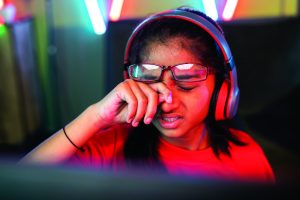Parents! Guard against early years digital addiction
In the new era of the ubiquitous smartphone, accelerating dependence on digital devices has snowballed into what some childcare experts describe as a latter-day parenting epidemic. Harassed middle class parents are increasingly resorting to a few swipes on the smartphone to silence a tantrum, buy ten minutes to finish a work call, or drink a cup of tea in peace – Kiran Balimane & Cynthia John.
 The victims of digital media addiction are getting younger by the day. A recent study by the All India Institute of Medical Sciences (AIIMS), Raipur, reveals that in urban India children under five years of age are spending an average 2.2 hours daily viewing digital screens. Another India-specific study published in BMJ Paediatrics Open (July), which surveyed 3,624 parents across five states, found that over 60 percent of infants aged two-five years are exposed to digital screens for two-four hours daily.
The victims of digital media addiction are getting younger by the day. A recent study by the All India Institute of Medical Sciences (AIIMS), Raipur, reveals that in urban India children under five years of age are spending an average 2.2 hours daily viewing digital screens. Another India-specific study published in BMJ Paediatrics Open (July), which surveyed 3,624 parents across five states, found that over 60 percent of infants aged two-five years are exposed to digital screens for two-four hours daily.
The average time spent by Indian infants by far exceeds the World Health Organisation (WHO) guidelines, which totally prohibits exposure of children under one year to digital media and recommends only one hour of supervised, high-quality content for children in the two-five age group.
Both the commendable Indian public interest studies warn that exposure of children in their critical early years to digital media is likely to result in their missing important developmental milestones. They are likely to experience slow language development, impaired cognitive function, hampered social skills development, risk of obesity, and disturbed sleep. “Screens were being used to feed, soothe, and occupy kids. Parents use screen time for their own rest, to carry out household chores, and pacify children. Children with higher screen time were found to engage less in talking with parents and peers, had reduced outdoor play and were less likely to participate in creative activities,” says the study published in BMJ Paediatrics Open.
This is endorsed by Priyank Bhutani, speech and hearing specialist, a Ph D scholar at Tezpur University and co-author of the study. Bhutani recalls that digital devices began as “digital helpers” and became indispensable during and after the Covid-19 pandemic. “They became the easiest option to keep children occupied while parents focused on daily responsibilities,” he says.
Since then in the new era of the ubiquitous smartphone, accelerating dependence on digital devices has snowballed into what some childcare experts describe as a latter-day parenting epidemic. In India’s crowded metros, fast-growing tier-II, III and IV cities and towns in which double-income nuclear household parents are obliged to manage demanding jobs, long commutes on traffic-choked roads, and unrelenting inflation, the smartphone and computer tablet are discharging the role of grandparents and siblings. Quasi-literate house helpers and nannies in upper middle class and elite households and illiterate grannies in cramped tenements and chawls are using digital devices to calm, cajole and soothe infants during mealtimes, car rides, in supermarket queues, and even to put toddlers to bed. Even harassed middle class parents are increasingly resorting to a few swipes to silence a tantrum, buy ten minutes to finish a work call, or drink a cup of tea in peace.
But paediatricians warn, these stolen moments of parental calm are likely to cost heavily by way of delaying or impairing children’s cognitive development in their critical formative years.“Reports of a rise in screen time of children aged below five is alarming because this is a critical time window for foundational brain development — a child’s brain is 80 percent developed by age eight. During this time, children should cross several development milestones such as language learning, fine and gross motor skills development, emotional regulation, and social skills. These capabilities are best nurtured through engagement with parents — talking, playing, exploring — and interacting with caregivers and peers. Time spent on digital devices in these formative years delays attainment of these development milestones, leading to delayed speech, reduced attention span, limited problem-solving skills, and diminished social confidence,” warns Dr. Chiranth R, a Bengaluru-based paediatrician and neonatologist.

Dr. Chiranth R
Dr. Chiranth believes it’s critical for parents to be well-informed about the cognitive and emotional damage inflicted upon youngest children by excessive screen viewing. He flags four important early childhood development milestones that could be delayed or missed by youngest children addicted to digital devices.
Language and communication setbacks. Children’s first words, understanding, and conversation skills develop and blossom through hearing and responding to live speech. It is scientifically well-established that language learning is most effective through human interaction, where children practice “joint attention” (looking at the same object as a parent) and “turn-taking” in conversation. New research has found that “extensive digital screen exposure is linked to lower white matter integrity in areas that support language, literacy, and cognitive skills of young children.” As a result, screens-addicted children have underdeveloped connections in brain regions (Broca’s and Wernicke’s areas) prompting delayed learning of first words and sentences; poor comprehension of instructions and stories. These children also display limited gestures, facial expressions, and eye contact difficulties. These setbacks can inflict lasting damage as children permanently struggle to catch up with peers.
Social and emotional learning delays. Youngest children develop social skills by reading parents and siblings’ faces, recognising emotions, and learning to adapt to unpredictable real-life situations. Unlike humans, digital screens don’t provide dynamic feedback or emotional response, which means less activation of the mirror neuron system essential for developing social skills. Fast-paced, predictable digital content cannot substitute human interaction, leading to reduced social interaction; greater frustration and tantrums, and difficulty managing emotions.
Poor motor and physical development. Growing children need physical movement — walking, running, climbing, jumping — to develop strong bodies and coordination. Development of balance and motor skills depends on hands-on, sensory-rich experiences, not watching mind-numbing digital devices. WHO warns that “inadequate physical activity in early childhood, much of which is due to screen time, is associated with delays in achieving motor milestones and overall physical health deficits”.
Disrupted sleep and reduced focus. It’s now well-established that bright, rapidly changing visuals from screens overstimulate the brain, especially of youngest children. Blue light from screens suppresses melatonin, making it harder for children to fall asleep, and fast-paced content keeps the nervous system on high alert. Numerous studies have concluded that “higher evening screen time is strongly associated with significantly shorter total sleep duration, delayed sleep onset, and increased sleep disturbances in toddlers”.
Beyond Dr. Chiranth’s physical and social developmental delays advisory, there’s a huge “emotional and educational” cost to preschoolers spending hours staring at digital screens. Early childhood education experts are unanimous that the 0-5 years time window is best utilised to build transformative parent-child emotional bonds and foundational learning skills.
“Reduced human, especially parent-child interaction, leads to weak bonds and trust, less empathy, and behavioural issues such as irritability and anxiety. Easy access to digital screens is making children impatient in real-life situations and classrooms. Moreover, parents using screens to pacify preschoolers have made the latter believe that emotional needs can be fulfilled by innate media rather than human interaction. As they grow older, this will make them susceptible to cyber stalking and online predators. Educationally, lack of play which is the best form of learning in early childhood, results in children experiencing cognitive delays and missing key foundational learning milestones,” warns Dr. Swati Popat Vats, the Mumbai-based President of the Early Childhood Association of India and Association for Primary Education and Research.

Lina Ashar
Elaborating on WHO advice of a maximum of one hour of “adult-supervised” screen time for children aged 2-5 years, well-known early childhood educationist Lina Ashar, who founded the Kangaroo Kids chain of 1,600 preschools and is currently founder-director of Dreamtime Learning, an online school, suggests ways to use the prescribed one hour productively:
- Ensure that during the 60 minutes of WHO-prescribed screen time, preschoolers view high quality interactive and play-based content which stimulates creativity and curiosity
- Search online for early childhood education apps specialising in foundational language and numeracy learning through play/games
- Physical fitness/dance apps for preschoolers are excellent to incorporate physical activity into your child’s daily routine.
- Search for meditation apps offering calming music, relaxation and mindfulness exercises. Also music apps that enable children to create music and learn to play musical instruments.
- Several apps also encourage preschoolers to draw and colour and learn art and crafts.
- Audio books are also excellent to initiate toddlers into the reading habit.
Curbing children’s screen habits

Dr. Swati Popat Vats
Dr. Swati Popat Vats, the erudite founder-director of the Early Childhood Association of India (estb.2011), advises parents to make sustained effort to reduce screen time of youngest children. “First and foremost, parents have to acknowledge that digital screens are not pacifiers and babysitters. They cannot be used to feed, soothe and entertain toddlers. It may be the easy option in the short term, but in the long term it will lead to irreparable development delays and damage. If children are already used to 2-3 hours of daily screen viewing, it will take a lot of effort, patience, consistency, and creativity to break them out of this habit. The solution is not to break the habit abruptly, but to gradually provide alternatives such as outdoor play, hands-on activities like blocks and puzzles, reading together, and involving them in simple household chores. When parents model balanced digital screens viewing habits themselves and create predictable routines, children will adapt,” advises Dr. Popat Vats to reduce children’s screens viewing time.

Set time limits. Restrict screen time to one hour per day for toddlers aged 2-5 years, while enabling access to high-quality educational content. Avoid high-volume and loud colour videos as they excite children’s developing senses.
Encourage physical activity. Gradually replace screen time with physical/play activities, outdoor play, sports, and activities that promote motor skills development — running, jumping, and climbing.
Promote art and crafts activities. Encourage art and crafts activities, reading, and interactive games that develop creativity.
Model healthy screen habits. Limit your own personal screens viewing time, especially in front of children, to model a balanced lifestyle.
Co-view and discuss. Use family screen time to ask questions and connect screen content to real-world experiences.
Demarcate screen-free zones at home. Designate screen-free zones such as the dining area/bedrooms, and screen-free times during meals and before bedtime, to encourage social interaction and play. Create a visual timetable for children to follow.
Negotiate a contract/agreement. This can be simple and visual, with the whole family signing it. Take your toddler through the visuals, explaining to them the home rules about digital screens viewing.
Around the world, as the disastrous impact of digital addiction on children is being acknowledged, parents are uniting to fight this new scourge. For instance, in the US, parents’ campaigns have pressured 25 state governments to legislate laws to ban children’s mobile phones in schools “bell-to-bell”, i.e, all day. In India, with new research warning that youngest children below age five are becoming addicted to digital media, there’s intensifying pressure on parents to act urgently and decisively. There is a clear danger that in the near future, millions of children will enter school — and later higher education — lacking the focus, skills, and readiness required to navigate and succeed in the new BANI (brittle, anxious, nonlinear, incomprehensible) age of uncertainty.
WHO guidelines
The World Health Organisation (WHO) recommends the following digital screen use guidelines for children under five years of age.
Infants (under one year). No screen time at all. Instead, they should be engaged in floor-based play and physical activity.
Toddlers (1-2 years). Limited screen time (less than one hour) with at least 180 minutes of physical activity daily.
Preschoolers (3-4 years). Limited screen time (one hour) and at least 180 minutes of physical activity, including 60 minutes of moderate to vigorous intensity.
*Please note that all of screen time should be supervised by an adult.
 Watch out for these missed
Watch out for these missed
development milestones
Dr. Chiranth R, a Bengaluru-based paediatrician and neonatologist, advises parents to watch for these signs, indicative of toddlers having missed important developmental milestones:
- Speech development delays — talking, following instructions
- Poor eye contact, little interest in social play, toys
- Awkward physical movements, slow crawling, walking development and poor hand-eye coordination
- Difficulty calming down unless provided a digital device
- Short attention span — easily distracted, unable to focus on tasks and play for age-appropriate durations
- Sleep disturbances — trouble falling asleep or sustaining sleep, especially after digital screen viewing.
- Frequent temper tantrums and irritability
- These symptoms should prompt a discussion with your paediatrician, as early intervention is vital.
Also Read: Prepping children for an uncertain future





 Watch out for these missed
Watch out for these missed










Add comment